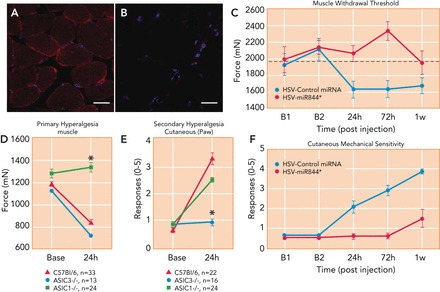FIGURE 2.

ASICs are expressed on muscle tissue and play a role in carrageenan-induced inflammatory muscle pain
A and B: representative muscle tissue sections from wild-type (A) and ASIC3−/− (B) mice, showing ASIC3 (red) and DAPI (nuclear stain, blue) staining. Figure reproduced from Ref. 114 with permission. C: genetic knockdown of ASIC3 in primary afferent fibers innervating muscle, using HSV-miRNA to ASIC3 (red, HSV-miR844), prevent the development of primary muscle hyperalgesia induced by intramuscular carrageenan injection compared with animals treated with control HSV-miRNA (blue). *Significantly greater than controls (P < 0.05). Reproduced from Ref. 114 with permission. D: muscle withdrawal thresholds (primary hyperalgesia) before and after induction of muscle inflammation in WT (red), ASIC3−/− (blue), and ASIC1−/− (green) mice. ASIC1−/− do not develop muscle hyperalgesia 24 h after inflammation with carrageenan compared with WT and ASIC3−/− mice. *Significantly greater than WT and ASIC3−/− (P < 0.05). Reproduced from Ref. 115 with permission. E: responses to repeated mechanical stimulation of the paw (secondary hyperalgesia) before and after induction of muscle inflammation in WT (red), ASIC3−/− (blue), and ASIC1−/− (green) mice. ASIC3−/− do not develop secondary hyperalgesia 24 h after inflammation with carrageenan compared with WT and ASIC1−/− mice. Reproduced from Ref. 115 with permission. F: genetic knockdown of ASIC3 in primary afferent fibers innervating muscle, using HSV-miRNA to ASIC3 (red, HSV-miR844), prevents development of secondary hyperalgesia induced by intramuscular carrageenan compared with animals treated with control HSV-miRNA (blue). *Significantly greater than controls (P < 0.05). Reproduced from Ref. 114 with permission.
